The front yard or front garden of residential areas is the part of the property between the street and the front of the house. And if the yard is covered with grass, it is called the front yard. Front yards intervene in the space between the property’s occupants and visitors or neighbors. Most front yards include a lawn, a driveway, a path, and some plantings. However, many other features can be added to a front yard to increase curb appeal.
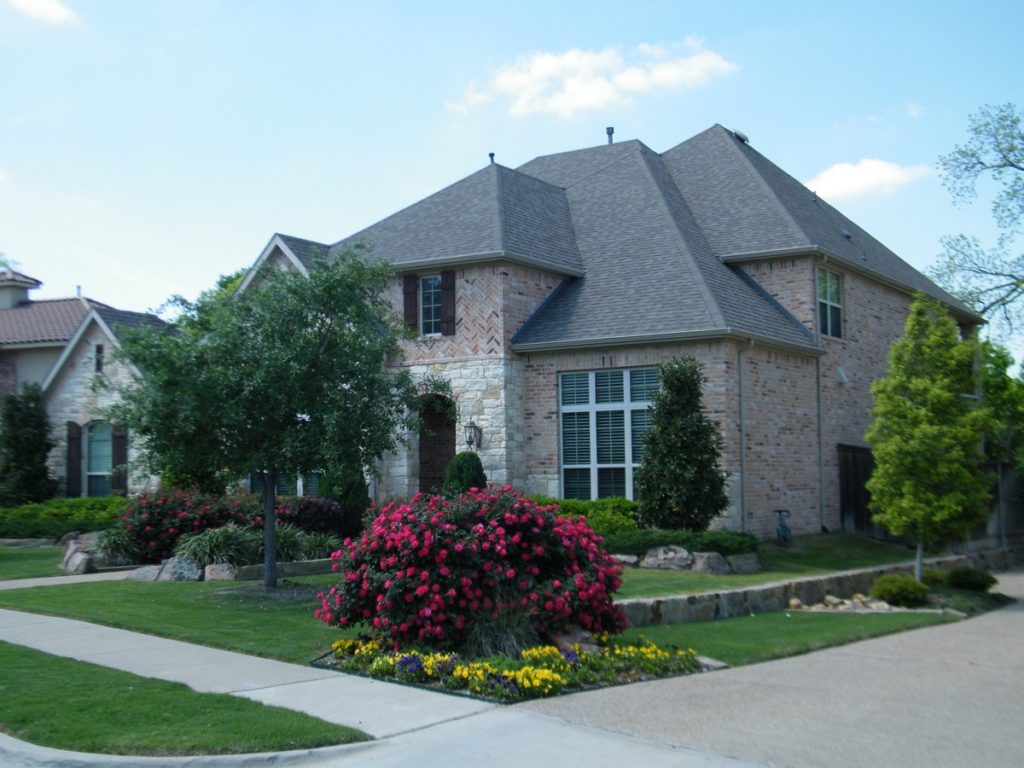
From fountains to decorative address markers, your front yard can stand out depending on the elements you add. Planning your landscape design can be overwhelming, but these simple front yard landscaping ideas are a great way to give your yard a professional look while staying on a budget. The best choice for a front yard tree depends on several factors, including your climate, available space, personal preferences, and landscape direction.
In addition to making your home attractive, proper landscaping can benefit the local ecosystem. When you choose to landscape your home, it can provide an ideal habitat for the wildlife native to your area. In addition, a well-designed front yard landscape with the right size and well-placed elements will enhance your home’s curb appeal.
Top 12 front yard landscaping ideas
Best time for starting front yard landscaping
You want to plant when the temperatures in your area are mild. It gives the plants time to acclimate to their beds without harsh weather. Spring is always a good time to plant front yard, but in many southern regions, fall is even better.
Cheap simple front yard landscaping ideas
These inexpensive, simple front yard landscaping ideas will go a long way in helping you design and install a beautiful front yard while staying on a budget.
Plant one or more trees for contemporary
Trees are a beautiful and budget-friendly solution for any front yard. Professionals recommend this idea for small front yards. A large tree can be the main focal point. You can invest in mature tree specimens to make them attractive, but you can save money by buying saplings instead of old trees. Trees can also help block unsightly views and reduce noise and air pollution if you live near a busy road. The conversion of carbon dioxide in the air into oxygen is of great benefit to nature.
Create a plan for your landscaping Ideas
Also, take a step back and think about the best placement for the larger elements you want to incorporate into your landscape design. Some ideas include a seating area, a water feature, a small water feature, outdoor lighting, or even a white picket fence. Landscaping is about completing your home, making it open and inviting. It has to go if an aspect dominates or distracts from the front of the house.
In case you missed it: How to Build a Fish Pond for Beginners: For Backyard, Outdoors, Start with Best and Cheap Ideas
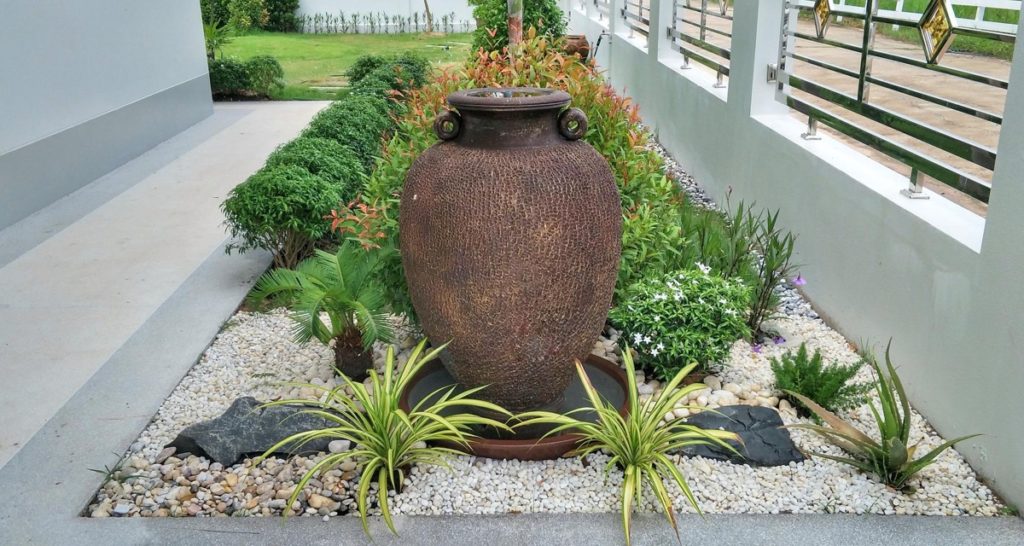
Plants for pollinators
Plants create a flower-lined pathway that serves as a buffet for pollinators such as bees, butterflies, and hummingbirds. These lovely perennials include ‘Millennium’ Ornamental Onions, Purple Russian Sage, and Peegee Hydrangeas. Planting brings a carefree atmosphere with a combination of textures and colors, the perfect accent for a cottage-style home.
Create a flower fence line
The classic white picket fence cottage-style planting provides a front yard flower border in the spades. Beautiful cottage garden bloomers include pink shrub roses, purple catmint, chartreuse lady’s mantle, and spiky purple meadow sage. Repeating blocks of color is a basic garden design principle that works just as beautifully in fence linings as in large garden borders.
Brick Edging for Flower Beds
A garden bed looks and feels complete when an edging is created. Not only does this separate the plant space, but it also keeps flowers from accidentally entering the area. This garden is edging and aims to keep things simple and affordable with the idea of stone bricks or pavers. They come in the same size and shape, making the edges easy. Use a hammer and a straight piece of wood to help drive the bricks firmly into the ground.
Plant perennial shrubs in front of your home
Once you plant perennials like Azaleas or Hydrangeas, they will return year after year as they bloom and add color to your front yard. Many are fairly inexpensive (around $40) and easy to maintain. Be sure to ask a local nursery specialist for information on planting them with enough space, when to prune, and how to trim perennials to prevent stunted growth.
Add lighting for front yard landscaping
Landscape lights are inexpensive (as cheap as $20) and are often solar-powered. It means you can easily choose your favorite colored lights, stick them on the ground along your walkway or flower bed, and turn them on to illuminate your front yard at night.
Sloped yard solutions
Tackle a sloping front yard with terraced planting beds. A mix of annuals, perennials, and evergreens ensures multi-season interest, even when the snow flies. Front yard patio steps, bed frames, and arched trellis wear the same shade of brown, allowing the background’s hardscape to fade so the plants can shine.
Hanging galvanized tub planter in the front yard
For inexpensive and easy front yard landscaping ideas, look in your garage or at a thrift store to find old galvanized tubs. They can be used as versatile flower planters. Place the tub directly on the ground to add a small flower garden to your lawn. If you have a post with your house number, you can suspend the tub vertically and expose the cascading petunias to the metal inside. String lights around the holder make this feature attractive at night.
In case you missed it: How to Grow Food at Home in Small Spaces: Tips, Techniques, and Ideas for Beginners
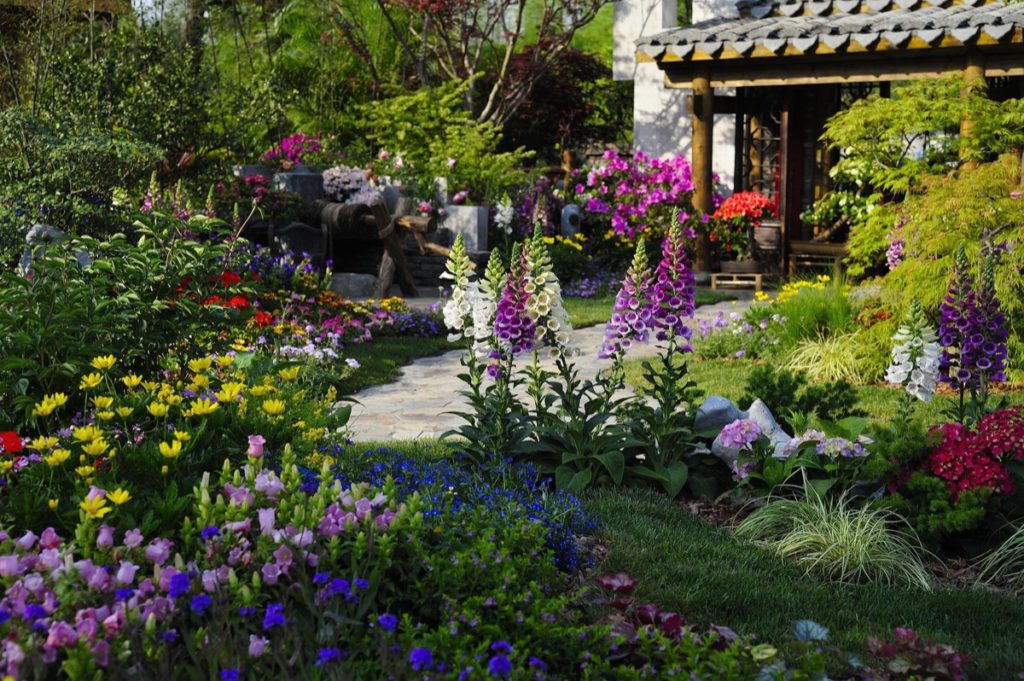
Decide on plant shapes and sizes
You don’t need to know what types of plants you use in your landscape design right now. You want to get an idea of the general shape and size. Different heights provide interest, so use larger plants in the back and smaller shrubs in front. As you get the plans down on paper, think more about plant shapes (e.g., tall and grassy vs. a short round bush vs. Christmas tree shape) than the specific types of plants you want.
Find large open spaces in front of your home and fill them with tall shrubs, small trees, or vines. Reserve a spot in the front of the beds to have annual flowers as a focal point. To create a colorful flower garden, you want to have mostly evergreens (larger plants) in the back and several perennials in the middle or front.
Plant shade trees
With bright spring flowers or stunning fall colors, a native hardwood tree planted in your front yard will bring years of beauty to your home’s exterior. Although some rare tree species are expensive and require maintenance, most trees in your area are hardy, resilient, and affordable at your local nursery. Expect to pay about $100–$200 plus delivery for a large tree.
Add rock features
Front yard landscaping ideas with rocks can also serve an important function in many cases, such as creating a rock spillway for your rain gutters to protect an area from excessive mud. Other ideas include breaking up beds or adding pea gravel borders to walkways. It will run around $20–$50, depending on how much surface area you cover.
Considerations for selecting the right plants for your front yard landscaping
Light Requirements – Most plants will have different light requirements, so it’s important to consider this when planning the best for your lighting situation. Suppose you have tall trees in your yard, many beautiful flowering plants, and shrubs like full or partial shade.
Another important thing you should consider before going to the nursery is what areas of your planned garden get morning sun, afternoon sun, all-day sun, or little sun. Watch your yard for a day at sunrise. Note the times each area is in the sun so you can get an idea of how many hours a day each area has. The selected plants need to be suited to the amount of sun in the area where you plan to plant them, so be aware of your specific conditions.
Choose plants for your climate – Not all plants do well in the same climate. It is advantageous to buy plants from a distributor or private nursery because they should only carry plants that will do well in your area. Be careful with big box stores because they are notorious for stocking plants that don’t thrive in your climate.
Start with trees and large shrubs – Trees and large shrubs are great places to start. Even if you don’t have the time or money to do your entire yard together, get the trees and shrubs going as soon as possible. It will give them a chance to grow. When we tackled our lake yard, we did it in stages. It is more affordable and allows us to fit it into our busy schedules. The first year we planted a series of trees and large shrubs.
The first thing to determine is the best location for the trees. Then add your perennials to your shrubs. Trees and shrubs are also ones that will provide year-round interest. Even if they are deciduous trees, they will still be a focal point in the winter garden.
In case you missed it: How to Start Organic Kitchen Gardening: Tips, Ideas, and A Step-By-Step Guide for Beginners
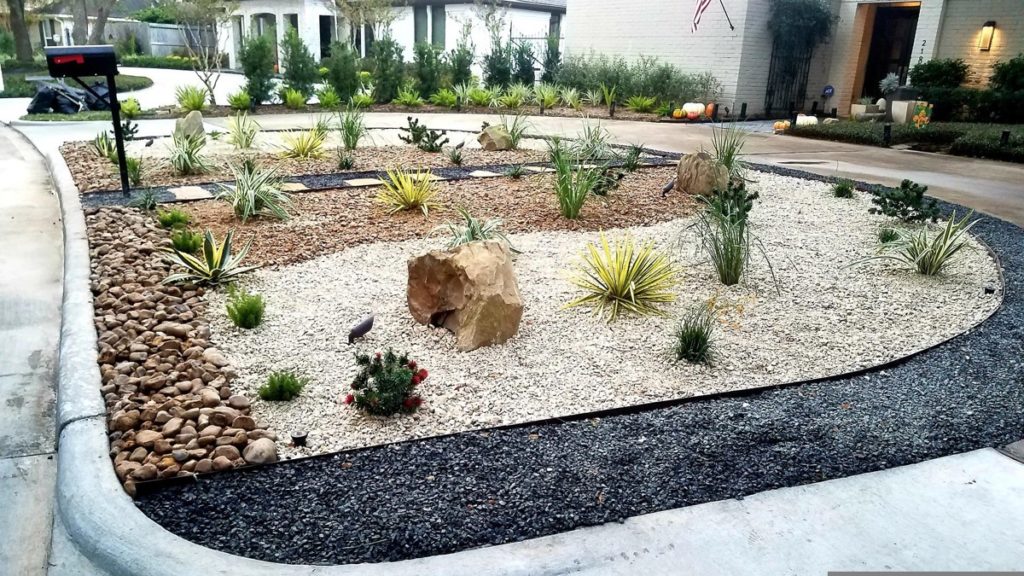
Things to keep in mind before implementing front yard landscaping
- The most important thing you need is a toolbox. Invest in a quality spade, hand trowel, garden rake, and a good wheelbarrow. These tools can be used to plan and maintain many years of inexpensive, simple front yard landscaping ideas.
- Before starting your front yard makeover, list what you need for your next cheap, simple yard landscaping idea and set a budget.
- Even the most complex cheap simple front yard landscaping ideas can be overwhelming without proper pruning of plants, healthy plants, and lush green grass. Before focusing on the cheap, simple front yard landscaping ideas, focus your energy on achieving a healthy front yard.
- You don’t have to choose one of those expensive fancy concrete slab and water fountain designs to have a beautiful front yard with a great view. Get started with these inexpensive and easy front yard landscaping ideas that will save you money without compromising your style and give you a look you want for your front yard.
Different ways to save money in front yard landscaping
Think about your watering system
- Many people who start a landscaping project run out of steam when they get close to watering, especially since using a lawn sprinkler can increase your utility bills. Creating strategic watering zones that reuse and conserve water is a good idea.
- Another method to save money on water is to build a rain garden. A rain garden is designed to direct rainwater away from your home and toward your plants. Eco-friendly and budget-friendly, a rain garden is smart for geographic areas with above-average rainfall and humidity.
- Using soaker hoses can also help you save money on sprinklers. Hose sprinklers are more efficient than traditional sprinklers because they deliver water directly to the roots of your plants instead of spraying water through the air.
Screening with Plants – If you don’t have a fence in your yard, you can plant a row of hawthorn, juniper, arborvitae, or these shrubs to create privacy and provide a backdrop for future flower beds. An evergreen screened area will also provide a wind break from winter winds and drifting snow.
Consider plant color and height when choosing plants for a plant bed. Planting an odd number of plants in the front yard is more visually appealing than an even number. As the name suggests, a land bed, an island bed, is planted in the middle of a yard surrounded by a sea of grass. It can change in shape and size based on your imagination and available space.
Plant selection for your front yard landscaping
You’ll want to plan them in stages: first, the driveway, attractive and durable steps and walkways, and then a porch or fence. Choose materials that enhance your landscape, not detract from its harmony. It’s easy to plant and replace, but you’ll want to be sure to place them in the right places so they can quickly become part of your design.
Trees, shrubs, and ground covers: Trees, shrubs, and ground covers are long-term purchases that grow in size and value and do not require much maintenance. You can use edible plants to enhance your landscape if you want fresh herbs, fruits, and vegetables.
Flowers: Flowers are a simple front yard landscaping idea requiring little maintenance and often replanting. Annuals—such as Kochia, Four O’clock, Strawflower, Impatiens, Moonflower, and Angel’s-Trumpet—and perennials—such as Peony, Bee Balm, and Hosta—can substitute for shrubs for the first year or two.
In case you missed it: Top 17 Steps/Ways to Boost Avocado Yield: How to Increase Production, Size, Quality, Tips, Methods, and Ideas
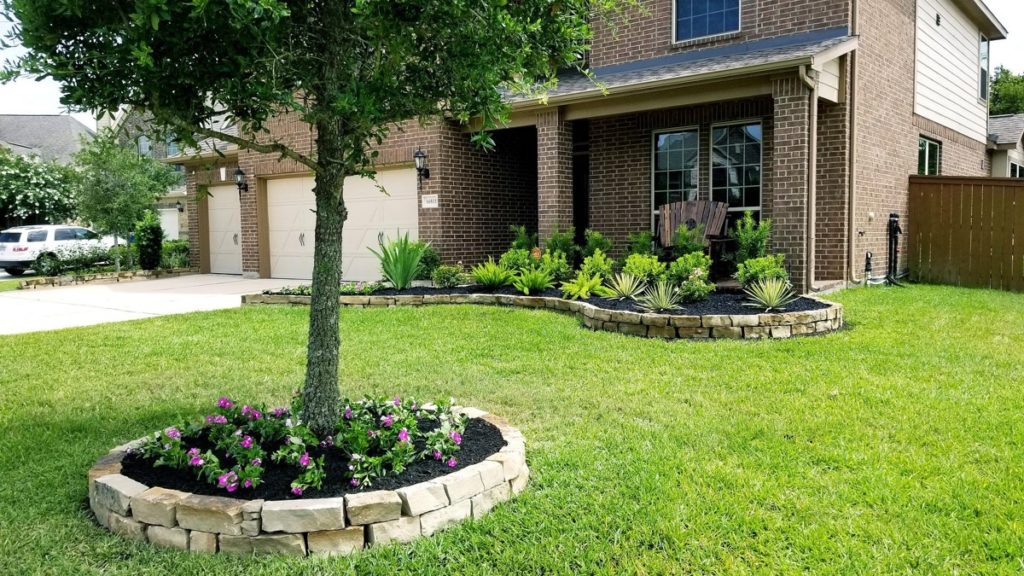
Flowering trees will add welcome color to your front yard after a harsh winter, often before the rest of your landscape comes alive. The effect is similar to placing a bouquet full of flowers in your front entry, providing temporary but stunning color and an intoxicating scent. In addition, flowering trees provide multi-season interest by producing colorful berries and vibrant fall foliage, such as Cherry Trees, Crape Myrtles, Crabapple Trees, and Eastern Redbuds.
Lawn – Lawns take the most resources, work, and equipment of any aspect of landscaping. To conserve natural resources and human energy, consider lawn alternatives, especially in areas with insufficient rainfall. Use mulch or ground cover for islands around trees and shrubs if your front yard is too large for constant mowing and watering. Fence an area for turf and use the rest for grassland, pasture, or woodland.
Trees for small spaces – When choosing a tree for a front yard or yard, look for a specimen that creates a focal point without dominating your home or landscape. Many small or dwarf trees will grow no taller than 25 feet but have eye-catching features that make up for their short statures, such as interesting leaf shapes and unique branch patterns. Good trees include Dogwoods, Japanese Maples, Weeping Cherry Trees, and Purple Leaf Plum.
Shade trees – Planting shade trees in front of your home can block the harsh morning and afternoon sun from reaching your windows and keep your home cooler in the summer. Their dense canopy of leaves also slows water evaporation from lawns and garden beds. Shade trees come in different shapes and sizes, but fast-growing varieties will provide their benefits sooner. Some examples include Red Maples, Pin Oaks, Poplars, Paper Birches, and American Sycamores.
Evergreen trees – While many deciduous trees will grace you with spring flowers and fall color, their glory often fades after the leaves drop in winter, leaving you with a lifeless landscape. You can also plant small evergreens in containers to create a formal entryway. Popular conifer species include Alberta Spruce, Skyrocket Juniper, Degroot Spire Arborvitae, and Globe Blue Spruce.
Plant trees for impact – Trees (and large shrubs) are the first components to consider in front yard design. A framed view is often more inviting than an open view. Consider the simple landscaping idea of planting one (or more) tall trees on either side and behind your home. Trees consistently look to the yard and house and soften the second floor or roof line against the sky. If your budget allows for one or two mature trees, plant them in the front yard. In addition to providing framing, trees and large shrubs – and buildings – create mass in the landscape.
Choose and place them for seasonal color interest, outline, shade, and energy control. Coordinate plant shapes—round, pyramid, weeping —with each other and the structure. Provide visual relief by carefully varying the size and shape of the leaves depending on the composition of the structural material. Trees and shrubs are also good for marking boundaries and separating active areas.
Cost for front yard landscaping
There must be elements you can’t live without – a dining area, an outdoor kitchen, or a garden.
- The material costs – Your choice of landscaping materials, from stone to lighting, can increase or decrease your budget and is where you can choose to spend or save.
- Cost of plants – It’s always worth investing in a few large, mature plants or trees to anchor your scheme.
- Design and labor costs – Stick to the budget for fixed costs in these areas, and keep a strict record of any extras you ask for.
- Furniture cost – If you are doing landscaping, you will likely need to save some of your budget for furniture.
Front yard landscaping costs an average of $1,500 to $5,000. Landscaping costs can change significantly, especially if you choose to landscape with potted plants, water features, or other large additions. The scope of your landscaping project, where you live, and the materials you choose will affect the cost estimate.
In case you missed it: Sugarcane Farming in the USA: How to Start, Production States, Ideas, and Tips
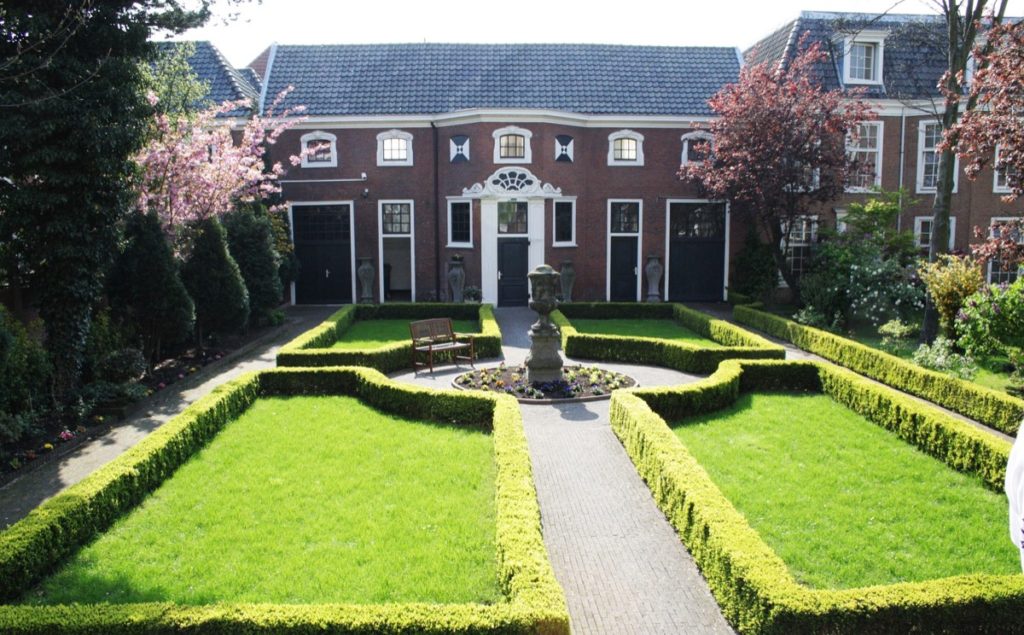
Commonly asked questions about front yard landscaping
What is the cheapest type of landscaping?
Consider a vertical garden if you’re working with a budget and a small front yard. This inexpensive landscaping design will have you picking vegetables, saving greens, and growing a green thumb. In addition, these mini gardens will help save space and make for a fun project.
How do I decorate my front yard?
- Add rock features
- Add lighting
- Upgrade the bed border
- Plant ground cover to hide unsightly spots
- Plant perennial shrubs in front of your home
- Build a garden bed around your mailbox
- Remove old mulch and freshen it up
- Make a flower bed around a tree
How can I make my front yard landscape beautiful?
When planning your front yard landscape design, beautifying the space will naturally be top of mind. Having the right architectural response is critical to the success of any front yard. The scale, shape, and materiality of your home’s architecture should all carry over into the landscape design, so it’s always a good first step to learn as much as possible about the home’s style and design before starting landscaping.
How tall should shrubs be in front of the house?
A medium-height shrub closest to your home should be 3 feet, but a tall shrub should be planted at least 5 feet from your home.
What are the benefits of landscaping?
Landscaping has great benefits, including increasing the value of your home, beautifying your space, the ability to reduce heating and cooling costs, and potential health benefits.
Conclusion
A great front yard landscape design will make your house feel like home. But most importantly, a front yard without an attractive garden is like a picture without a real frame. A professionally landscaped front yard reflects the owner’s personality and lifestyle. Also, it makes the home look more inviting and comfortable. The above are the top front yard landscaping ideas for low maintenance and provides a beautiful space in front of your home.
- Types of Pesticides Used in Agriculture: A Beginner’s Guide
- Economical Aquaculture: A Guide to Low-Budget Fish Farming
- 15 Common Planting Errors That Can Doom Your Fruit Trees
- How to Make Houseplants Bushy: Effective Tips and Ideas
- Innovative Strategies for Boosting Coconut Pollination and Yield
- Pollination Strategies for Maximum Pumpkin Yield
- The Complete Guide to Chicken Fattening: Strategies for Maximum Growth
- Natural Solutions for Tulip Problems: 100% Effective Remedies for Leaf and Bulb-Related Issues
- Revolutionizing Citrus Preservation: Towards a Healthier, Greener Future
- Natural Solutions for Peony Leaf and Flower Problems: 100% Effective Remedies
- Maximizing Profits with Avocado Contract Farming in India: A Comprehensive Guide
- Natural Solutions for Hydrangea Problems: 100% Effective Remedies for Leaf and Flowers
- The Ultimate Guide to Choosing the Perfect Foliage Friend: Bringing Life Indoors
- From Sunlight to Sustainability: 15 Ways to Use Solar Technology in Agriculture
- The Ultimate Guide to Dong Tao Chicken: Exploring from History to Raising
- The Eco-Friendly Makeover: How to Convert Your Unused Swimming Pool into a Fish Pond
- Mastering the Art of Delaware Chicken Farming: Essentials for Healthy Backyard Flocks
- 20 Best Homemade Fertilizers for Money Plant: DIY Recipes and Application Methods
- How to Craft a Comprehensive Free-Range Chicken Farming Business Plan
- Brighten Your Flock: Raising Easter Egger Chickens for Beauty and Bounty
- How to Optimize Your Poultry Egg Farm Business Plan with These Strategies
- Subsidy for Spirulina Cultivation: How Indian Government Schemes Encouraging Spirulina Farmers
- Ultimate Guide to Raising Dominique Chickens: Breeding, Feeding, Egg-Production, and Care
- Mastering the Art of Raising Jersey Giant Chickens: Care, Feeding, and More
- Ultimate Guide to Raising Legbar Chickens: Breeding, Farming Practices, Diet, Egg-Production
- How to Raise Welsummer Chickens: A Comprehensive Guide for Beginners
- How to Protect Indoor Plants in Winter: A Comprehensive Guide
- Ultimate Guide to Grow Bag Gardening: Tips, Tricks, and Planting Ideas for Urban Gardeners
- Guide to Lotus Cultivation: How to Propagate, Plant, Grow, Care, Cost, and Profit
- Agriculture Drone Subsidy Scheme: Government Kisan Subsidy, License, and How to Apply Online
- Ultimate Guide to Raising Araucana Chickens: Breed Profile, Farming Economics, Diet, and Care
- Bringing Hydroponics to Classroom: Importance, Benefits of Learning for School Students
- Ultimate Guide to Raising Polish Chickens: Breed Profile, Farming Economics, Diet, and Care
- Ultimate Guide to Raising Australorp Chickens: Profile, Farming Economics, Egg Production, Diet, and Care
- Silkie Chicken Farming: Raising Practices, Varieties, Egg Production, Diet, and Care
- Sussex Chicken Farming: Raising Practices, Varieties, Egg Production, Diet and Care